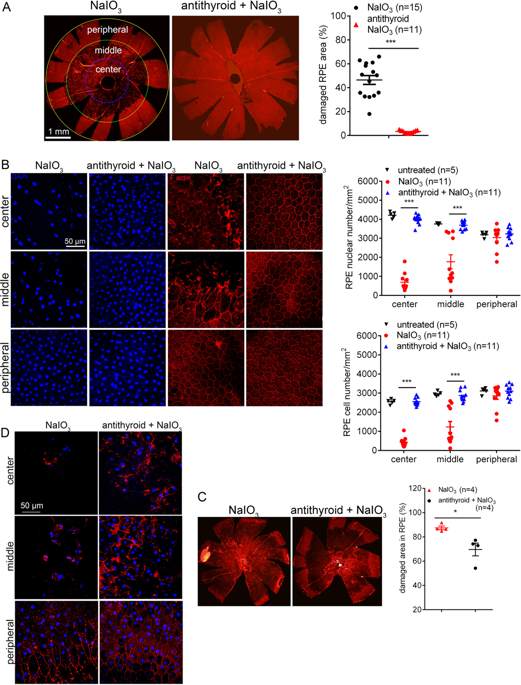当前位置:
X-MOL 学术
›
Cell Death Dis.
›
论文详情
Our official English website, www.x-mol.net, welcomes your
feedback! (Note: you will need to create a separate account there.)
Inhibition of thyroid hormone signaling protects retinal pigment epithelium and photoreceptors from cell death in a mouse model of age-related macular degeneration.
Cell Death & Disease ( IF 8.1 ) Pub Date : 2020-01-13 , DOI: 10.1038/s41419-019-2216-7 Hongwei Ma 1 , Fan Yang 1 , Xi-Qin Ding 1
Cell Death & Disease ( IF 8.1 ) Pub Date : 2020-01-13 , DOI: 10.1038/s41419-019-2216-7 Hongwei Ma 1 , Fan Yang 1 , Xi-Qin Ding 1
Affiliation

|
Age-related macular degeneration (AMD) is the leading cause of blindness in the elderly. Dry AMD is characterized by a progressive macular degeneration of the retinal pigment epithelium (RPE) and photoreceptors, and the RPE oxidative damage/dystrophy is at the core of the disease. Recent population/patients-based studies have shown an association of high free serum thyroid hormone (TH) levels with increased risk of AMD. This work investigated the effects of TH signaling inhibition on RPE and photoreceptor damage/cell death in an oxidative stress-induced mouse model of AMD. TH signaling inhibition was achieved by anti-thyroid drug treatment and oxidative stress was induced by sodium iodate (NaIO3) administration. Mice treated with NaIO3 showed severe RPE and photoreceptor cell death/necroptosis, destruction, oxidative damage, retinal stress, and reduced retinal function. Treatment with anti-thyroid drug protected RPE and photoreceptors from damage/cell death induced by NaIO3, reduced oxidative damage of RPE and photoreceptors, and preserved retinal function. Gene expression analysis showed that the NaIO3-induced RPE/photoreceptor damage/cell death involves multiple mechanisms, including cellular oxidative stress responses, activation of necroptosis/apoptosis signaling, and inflammatory responses. Treatment with anti-thyroid drug abolished these cellular stress/death responses. The findings of this study demonstrate a role of TH signaling in RPE and photoreceptor cell death after oxidative stress challenge, and support a role of TH signaling in the pathogenesis of AMD.
中文翻译:

在年龄相关性黄斑变性小鼠模型中,抑制甲状腺激素信号可保护视网膜色素上皮和光感受器免于细胞死亡。
年龄相关性黄斑变性(AMD)是老年人失明的主要原因。干性AMD的特征是视网膜色素上皮(RPE)和光感受器的进行性黄斑变性,而RPE氧化损伤/营养不良是该疾病的核心。最近基于人群/患者的研究表明,高游离血清甲状腺激素 (TH) 水平与 AMD 风险增加存在关联。这项工作研究了氧化应激诱导的 AMD 小鼠模型中 TH 信号传导抑制对 RPE 和光感受器损伤/细胞死亡的影响。 TH 信号传导抑制是通过抗甲状腺药物治疗实现的,氧化应激是通过给予碘酸钠 (NaIO3) 诱导的。用NaIO3治疗的小鼠表现出严重的RPE和感光细胞死亡/坏死性凋亡、破坏、氧化损伤、视网膜应激和视网膜功能降低。抗甲状腺药物治疗可保护 RPE 和光感受器免受 NaIO3 诱导的损伤/细胞死亡,减少 RPE 和光感受器的氧化损伤,并保留视网膜功能。基因表达分析表明,NaIO3诱导的RPE/光感受器损伤/细胞死亡涉及多种机制,包括细胞氧化应激反应、坏死性凋亡/凋亡信号的激活和炎症反应。抗甲状腺药物治疗消除了这些细胞应激/死亡反应。本研究的结果证明了 TH 信号传导在氧化应激挑战后 RPE 和感光细胞死亡中的作用,并支持 TH 信号传导在 AMD 发病机制中的作用。
更新日期:2020-01-13
中文翻译:

在年龄相关性黄斑变性小鼠模型中,抑制甲状腺激素信号可保护视网膜色素上皮和光感受器免于细胞死亡。
年龄相关性黄斑变性(AMD)是老年人失明的主要原因。干性AMD的特征是视网膜色素上皮(RPE)和光感受器的进行性黄斑变性,而RPE氧化损伤/营养不良是该疾病的核心。最近基于人群/患者的研究表明,高游离血清甲状腺激素 (TH) 水平与 AMD 风险增加存在关联。这项工作研究了氧化应激诱导的 AMD 小鼠模型中 TH 信号传导抑制对 RPE 和光感受器损伤/细胞死亡的影响。 TH 信号传导抑制是通过抗甲状腺药物治疗实现的,氧化应激是通过给予碘酸钠 (NaIO3) 诱导的。用NaIO3治疗的小鼠表现出严重的RPE和感光细胞死亡/坏死性凋亡、破坏、氧化损伤、视网膜应激和视网膜功能降低。抗甲状腺药物治疗可保护 RPE 和光感受器免受 NaIO3 诱导的损伤/细胞死亡,减少 RPE 和光感受器的氧化损伤,并保留视网膜功能。基因表达分析表明,NaIO3诱导的RPE/光感受器损伤/细胞死亡涉及多种机制,包括细胞氧化应激反应、坏死性凋亡/凋亡信号的激活和炎症反应。抗甲状腺药物治疗消除了这些细胞应激/死亡反应。本研究的结果证明了 TH 信号传导在氧化应激挑战后 RPE 和感光细胞死亡中的作用,并支持 TH 信号传导在 AMD 发病机制中的作用。











































 京公网安备 11010802027423号
京公网安备 11010802027423号